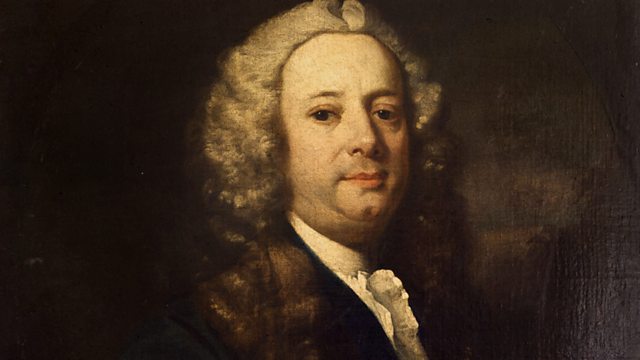
Episode 1
Donald Macleod surveys Geminiani's early life, from his time in Lucca, where he was born, to arrival in London, and tuition with Corelli and Alessandro Scarlatti.
Francesco Geminiani was considered something of a musical god, deemed to be the equal of Handel and Corelli, a master without parallel in the art of composition in 18th century London - Donald Macleod traces the life and music of this now largely forgotten composer.
Geminiani's life began in Lucca, initially learning the violin from his father, then on to lessons with Il Gobbo - "the Hunchback". He'd also go on to be tutored by two Arcadian masters, counterpoint with Alessandro Scarlatti, and additional violin lessons with Corelli.
On arrival in London in 1714, Geminiani would launch himself into print with his own arrangements of works by Corelli. People who wanted to be considered to be someone of note would undertake the Grand Tour of Italy, where they would come across the music of Corelli. Subsequently, Corelli was hugely popular in England, and any musician who could claim some sort of lineage to the Italian master, was sure of a flourishing career. Soon Geminiani would soon be presented to King George I, accompanied at the harpsichord by Handel.
Throughout his career, Geminiani would be celebrated not only as a composer, but also as a performer. Tartini would name him Il Furibondo, the 'wild' or 'furious' one. Due to his excellence as a performer, his compositions were sometimes far too advanced for the public to perform. However, his opus 2 and opus 3 Concerti grossi would become his most popular pieces, often performed in concert halls and also between the acts of stage works.
Another enterprise of Geminiani's was the writing of a number of Treaties, such as on accompaniment, or The Art of Playing the Guitar. His publication entitled The Art of Playing the Violin would become as popular as his opus 3 set. It was the first work of its kind, intended for professionals to standardise playing the violin. This Treaty, including its 'Geminiani Grip', has influenced performers today and is an invaluable source for understanding the Italian School of music from that period.
Geminiani travelled for much of his life between London, Paris and Dublin, seeking the next project to launch himself into. Although he was deemed great by some, a "God" amongst musicians, many of his publications were in fact financial failures. He was also nicknamed a 'Reheater', on account of the amount of times he would publish the same work, revised or arranged for different instruments. He died in 1762 in Dublin, yet despite the unsettled financial nature of his career, he remained as popular as ever in England up until 1800, especially with his Opus 3 Concerto grossi.
In today's programme on the life and music of Francesco Geminiani, Donald Macleod traces the composer's early life, from his beginnings in Lucca to his arrival in London. This journey took Geminiani through Naples, where he was for a brief time leader of the orchestra. However, his tempo was so unsteady, with unexpected accelerations and relaxations, that the musicians and singers complained. Geminiani was clearly a natural soloist, of independent mind, as demonstrated in his Sonata for Violin Solo in B flat major.
Geminiani was taught the violin not only by his father, but also by Il Gobbo - "the Hunchback". He was also to have lessons in counterpoint with Alessandro Scarlatti, and additional tutoring on the violin from Corelli. It was Geminiani's association with Corelli that would pave the way for his own success in London. The music of Corelli was very popular in England during the 18th century, and once Geminiani arrived in London, he printed a number of works including the Concerto grosso in D minor no. 12, which was an arrangement of Corelli's La Follia.
Soon Geminiani would find an influential supporter, in the guise of Baron Kielmansegg, who arranged for Geminiani, accompanied by Handel at the harpsichord, to perform in front to King George I at St. James's Palace. Geminiani went on to dedicate his first published compositions to Baron Kielmansegg, including the Opus 1 Sonatas.
Last on
More episodes
Previous
You are at the first episode
Music Played
-
![]()
Francesco Geminiani
Concerto grosso in D minor Op.2 No.3 (pub.1732)
Performer: Tafelmusik, Jeanne Lamon, director
- SONY SK48043.
-
![]()
Francesco Geminiani
Sonata for Violin Solo in B flat major
Performer: Anton Steck, violin
- CPO 7772252.
-
![]()
Francesco Geminiani
Concerto grosso in D minor no 12 (after Corelli: La Follia op.5 no.12, pub.1729)
Performer: Europa Galante, Fabio Biondi, director
- Opus111 OPS30172.
-
![]()
Charles Avison
Concerto Grosso no 6 in G minor (arr. Geminiani Sonata Op.1 No.6)
Performer: The Avison Ensemble, Pavlo Beznosiuk
- Divine Art dda21210.
Broadcasts
- Mon 21 Feb 2011 12:00����ý Radio 3
- Mon 21 Feb 2011 22:00����ý Radio 3
Beethoven Unleashed – the box set
What was really wrong with Beethoven?
Composers A to Z
Who knew? Five eye-opening stories from Composer of the Week
Five reasons why we love Parry's Jerusalem
What is the strange power of Jerusalem which makes strong men weep?
A man out of time – why Parry's music and ideas were at odds with his image...
The composer of Jerusalem was very far from the conservative figure his image suggests.
Composer Help Page
Find resources and contacts for composers from within the classical music industry.





